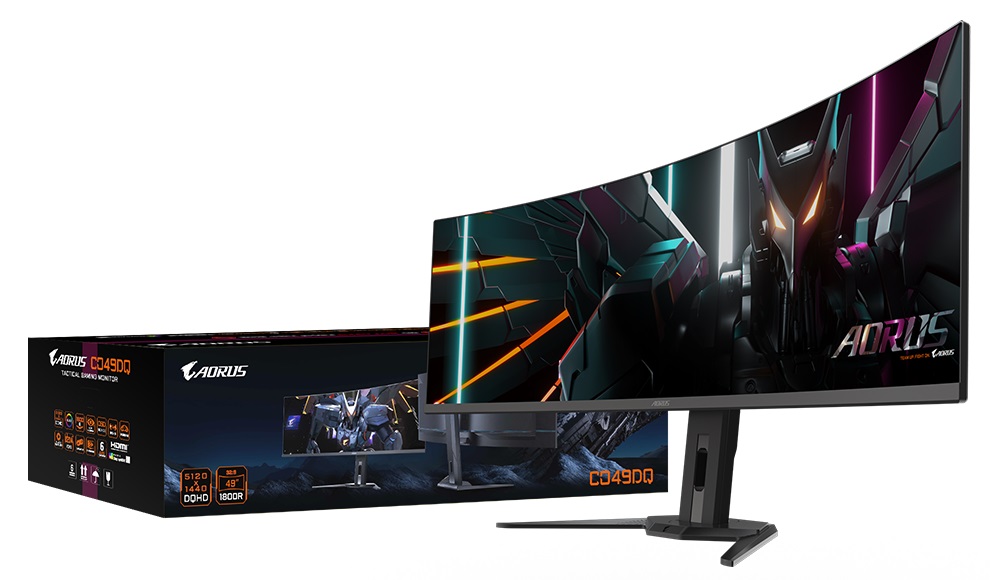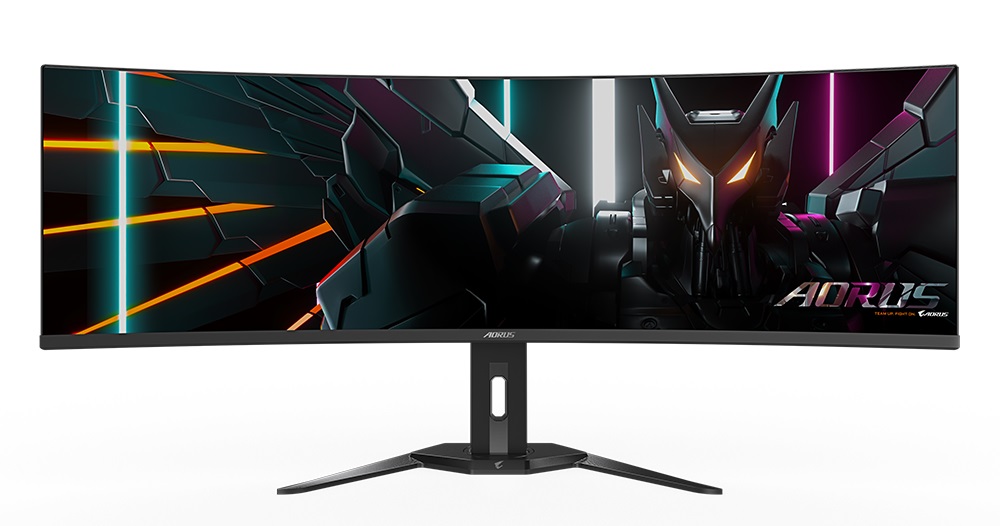AI comes to massive gaming monitor to solve burn-in problems - Aorus CO49DQ 49-inch super ultrawide QD-OLED gaming screen
Avoid the pain of super ultrawide OLED burn-in

Gigabyte has launched the Aorus CO49DQ Gaming Monitor. Highlights of this new super ultra-wide display include its 49-inch QD-OLED panel, with a DQHD 5120 x 1440 pixels resolution, and an 1800R curvature. Gamers may also appreciate its 144 Hz refresh rate, 0.03 ms g2g response time, and gaming 'tactical features'.
As well as the gaming-friendly features, the Aorus CO49DQ is pitched as a good fit for multi-tasking and content creation tasks. Productivity use cases mentioned by Gigabyte include film editing and music editing. For some of those tasks, a monitor may need good color specs and this QD-OLED screen has 10-bit color, a 99% DCI-P3 gamut, and is certified for VESA DisplayHDR True Black 400. Some will also appreciate the eye-comfort of the non-glare panel. Multi-tasking is embraced by the monitor providing both picture-in-picture (PiP) and picture-by-picture (PbP) modes.



AI for Burn-In Prevention?
The word 'AI' is a new buzzword and we'll see a lot of it used either as a genuine innovation and expansion, or just a marketing term for functions that have little to do with machine learning. Aorus claims to use an AI-based algorithm to minimize the risk of burn-in issues by using a series of OLED protection technologies described as 'OLED Care' functionality. In the manual, the OSD shows options like Care+, usage time, pixel clean, static control, pixel shift, APL stabilize, and sub-logo Dim.
I am intrigued to know if it uses an AI algorithm to minimize this lingering issue with OLED panels - and how it functions irrespective of the fact. One might be more optimistic about its real-world performance, once it has been put through third-party burn-in torture tests with these functions enabled.
It is nice to have burn-in protection features that work, AI or otherwise. It is also good to see companies mentioning the warranty period and assuring burn-in issue is covered, like how LG and Corsair do on their respective websites. I am sure many would agree this is a piece of necessary information, especially with OLED monitors. I couldn't get any information about this monitor's warranty period- either on the website, the specs, or the manual and there's no downloadable warranty card. Here's hoping Gigabyte will be clear about its warranty period shortly.
I/O and Other Features
For input, the Aorus CO49DQ has two HDMI 2.1 ports with CEC support and a DisplayPort 1.4 with HBR3 for video input. Meanwhile, a DP-Alt with 18w PD USB Type-C and two Type-A USB 3.2 pass-throughs is enabled through the USB 3.2 Type-B upstream connector. There is a headphone jack, and two 5W speakers are present.
For ergonomics it has swivel and tilt adjustment, but no height adjustment. There is an option to get a third-party arm or desk mount as this monitor provides a 100 x 100 VESA mounting.
Get Tom's Hardware's best news and in-depth reviews, straight to your inbox.
Gigabyte regularly provides KVM features in many of its monitors by default and the CO49DQ is no different. This is a useful feature that justifies a certain premium since people like to swap between their desktop, mobile phone, and laptop if and when needed using the aforementioned PiP and PbP modes. The power supply is built-in, unlike many monitors that usually come with a power brick. It is rated to consume a maximum of 72 watts.
The rest of the features are typical of modern Aorus gaming monitors - OSD Sidekick, Black Equalizer, Dashboard, Crosshair, Timer, Counter, firmware auto-update, and others.
The State of DQHD QD-OLED Monitors
It seems that we'll see plenty of 49-inch QD-OLED monitors with 1800R with DHQD 5120 x 1440 resolution, and a 144Hz refresh rate in 2024. The Aorus CO49DQ, MSI MPG 491CQP, and the RedMagic Realm seem to all be based on the same (Samsung) panel, and we could see more.

Roshan Ashraf Shaikh has been in the Indian PC hardware community since the early 2000s and has been building PCs, contributing to many Indian tech forums, & blogs. He operated Hardware BBQ for 11 years and wrote news for eTeknix & TweakTown before joining Tom's Hardware team. Besides tech, he is interested in fighting games, movies, anime, and mechanical watches.
-
Alvar "Miles" Udell Doesn't really sound any different than what OLED TVs from LG and Samsung already do to try and prevent burn in, likely since this features an OLED panel from one of them and uses their tech with Gigabyte's terms.Reply
But remember the words of Toms Guide's editor:
https://www.tomsguide.com/opinion/i-didnt-fear-burn-in-on-my-oled-gaming-monitor-until-i-got-burned -
Amdlova Oled in Phones have drama think in desktop :)Reply
I remember when a plasma is a thing lots of screen with burn in of start button...
Got for free and plasma tv because of it -
helper800 Reply
So he forgot to use F11 in Chrome and used it for hours a day with a no dark theme. It seems that this could have been prevented or at least delayed for years of the same use with just F11...Alvar Miles Udell said:Doesn't really sound any different than what OLED TVs from LG and Samsung already do to try and prevent burn in, likely since this features an OLED panel from one of them and uses their tech with Gigabyte's terms.
But remember the words of Toms Guide's editor:
https://www.tomsguide.com/opinion/i-didnt-fear-burn-in-on-my-oled-gaming-monitor-until-i-got-burned -
Soul_keeper Reply
Yes!thisisaname said:Is Ai now being used has a digital snake oil?
They figure the consumer is dumb enough to fall for the AI marketing pixie dust.
All the companies are doing it now. Really nothing new has been created. -
watzupken AI either requires the hardware or needs to connect online. I don’t think the monitor have either of these. More like marketing gimmick to me. And to be honest, you don’t need any AI solution for things like this.Reply -
helper800 Reply
There already exists ultra low power AI chips with low costs that could be put into monitors, phones, and pretty much any other small device with better performance per watt than the CPUs and GPUs that have integrated AI stuff in their silicon.watzupken said:AI either requires the hardware or needs to connect online. I don’t think the monitor have either of these. More like marketing gimmick to me. And to be honest, you don’t need any AI solution for things like this. -
Alvar "Miles" Udell Replythisisaname said:Is Ai now being used has a digital snake oil?
Not so much snake oil as just a cover term for things which may not even be "intelligent". Basically, anything that runs automatically on an algorithm can be classified as "AI" in today's world (which covers about half a Googleplex of things), which doesn't make them "snake oil", as that would imply they don't work at all, but you need to look beyond the buzzword and find out what it means.
Heck, ASUS has been using "AI" as their software suite name for near 20 years, but it doesn't mean it's ever been "AI" (or useful). -
thisisaname Reply
Mis-used rather than snake-oil?Alvar Miles Udell said:Not so much snake oil as just a cover term for things which may not even be "intelligent". Basically, anything that runs automatically on an algorithm can be classified as "AI" in today's world (which covers about half a Googleplex of things), which doesn't make them "snake oil", as that would imply they don't work at all, but you need to look beyond the buzzword and find out what it means.
Heck, ASUS has been using "AI" as their software suite name for near 20 years, but it doesn't mean it's ever been "AI" (or useful).